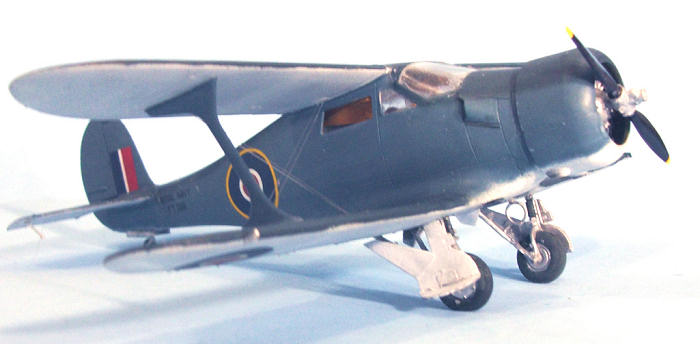
Roden 1/48 UC-43 Staggerwing
| KIT #: | 442 |
| PRICE: | $52.99 SRP |
| DECALS: | Three options |
| REVIEWER: | Tom Cleaver |
| NOTES: | New tool kit |

| HISTORY |
Today the Beech Staggerwing is considered “the Learjet of the 1930s.”
Myself, I like to think of it as the 1932 Duesenberg Model J of airplanes
- it certainly reminds one of that great 1930s classic from the iconic exterior
to the sumptuous interior.
Following the merger of the Travel Air Manufacturing Company with the
Curtiss‑Wright Airplane Company in mid 1929, Travel Air co‑founder Walter Beech
was given the position of President of the Aircraft Division.
Consumed with the desire to pursue his passion for aircraft design, Beech
resigned and moved to
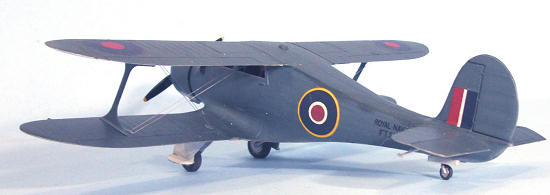 As the last Travel Air aircraft built had been the Model 16, Beech chose
to follow the numerical sequence and gave his new aircraft the name Beech Model
17. First flown on
As the last Travel Air aircraft built had been the Model 16, Beech chose
to follow the numerical sequence and gave his new aircraft the name Beech Model
17. First flown on
The reason for the unusual design was that staggering the wings in this
manner maximized the pilot’s visibility while minimizing the tendency to stall,
since the angle of incidence was such that the upper wing stalled first.
The Staggerwing’s use of then-uncommon retractable landing gear, combined
with streamlining and weight reduction, gave the Model B17 a top speed of 175
mph powered by a 225 h.p. Jacobs, a climb rate of 1,600 fpm, a maximum cruising
altitude of 21,500 feet, and a stall-proof landing speed of 45 mph, which
allowed the airplane to operate from any airfield.
With a then-high price of between $14-17,000 depending on the engine,
sales were slow in a depressed market and only two Model 17s were produced in
1933, both financed by an Oklahoma oil man; 18 were produced in 1934.
Each Staggerwing was custom‑built. A luxurious cabin trimmed in leather
and mohair, carrying up to five passengers in comfort, quickly won over the
customers. The Model 17's impressive performance also made it a favorite among
pilots - with radial engines ranging from 225 to 710 horsepower, it was faster
than most military aircraft of the era.
The higher-powered models had a 200 m.p.h. cruise, which might as well
have been Mach One in those days.
What sold the Staggerwing was its record-setting performance.
The 1933 Texaco Trophy Race was won by a Model B17, while Capt. H.L
Farquhar flew a Staggerwing around the world from
Several Model B17 Staggerwings were used as bombers by Republican Forces
in the Spanish Civil War. China
used eight as air ambulances, while the Finnish Air Force had one as a transport
from 1940-45 and used a Model G17S from 1950-58.
In 1937, Beech began a major redesign, which resulted in the Model D17,
considered by many to be the “classic” S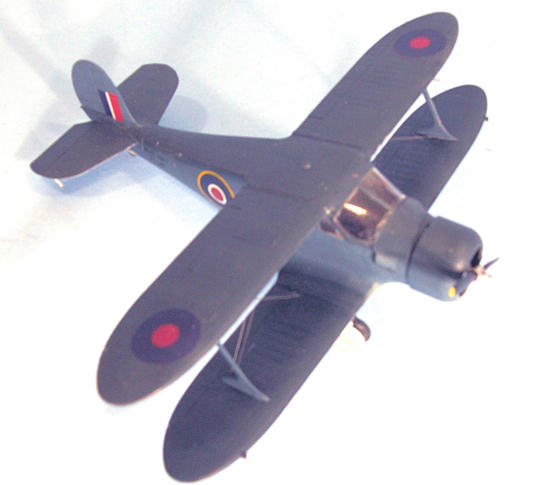 taggerwing.
It featured a lengthened fuselage that improved the landing
characteristics, a shorter landing gear that improved vision on the ground,
while the ailerons were relocated on the upper wings, eliminating interference
with the air flow over the flaps. A
foot‑operated brake synchronized with the rudder pedals was introduced.
With a 450 h.p. Pratt and Whitney R‑985 engine, the Model D17S had a top
speed of 212 m.p.h. and a cruise speed of 202 m.p.h.
260 were produced during World War II, designated UC‑43 by the USAAF
taggerwing.
It featured a lengthened fuselage that improved the landing
characteristics, a shorter landing gear that improved vision on the ground,
while the ailerons were relocated on the upper wings, eliminating interference
with the air flow over the flaps. A
foot‑operated brake synchronized with the rudder pedals was introduced.
With a 450 h.p. Pratt and Whitney R‑985 engine, the Model D17S had a top
speed of 212 m.p.h. and a cruise speed of 202 m.p.h.
260 were produced during World War II, designated UC‑43 by the USAAF
In 1946, the final Staggerwing, the Model G17S, was introduced.
With an improved cowling, streamlined windscreen, and larger rudder to
take on increased power, the G17S was the fastest Staggerwing of all with an
easy 220 m.p.h. cruise after the airframe cleanup.
Sixteen were produced by the time production ended.
However, the day of the Staggerwing was over as Beech went on the next
year to produce the finest single-engine general aviation airplane ever flown,
the Beech Bonanza. The last
Staggerwing came off the
In 1970, due to a dispute with the T‑6 racing class, the
Today, there are still over 270 Staggerwings in existence, with fewer
than 100 flying, 61 years after the last one was built.
They still draw a crowd wherever they land, and still compare favorably
in performance with all other piston-engine general aviation aircraft ever
flown. Yours truly had the
opportunity to fly a Staggerwing at the 1977
Technologically advanced for its time, the timeless beauty of the Beech Staggerwing coupled with its still-outstanding performance, puts this great classic in a class of one. In the April, 2007 issue of AOPA Pilot magazine, the Staggerwing was voted by nearly 3000 AOPA members as “Most Beautiful Airplane,” calling it “the perfect balance between muscular strength and delicate grace,” and rating it high for its “classic lines and symmetry." The last production model sold in 1949 for $29,000; you can’t touch one today that’s restored and flying for less than $500,000.
| THE KIT |
The only other 1/48 Staggerwing kit was the Model G17S released in the
late 1970s by 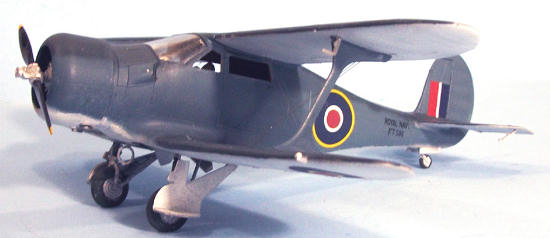 also
released in the 1970s.
also
released in the 1970s.
| CONSTRUCTION |
Overall, this is a simple kit.
So simple, in fact, that I was able to do it as a “weekender” even with
the added duties here of chief cook, bottle washer and maid, the result of SWMBO
having fractured her humerus two weeks ago in a slip-and-fall.
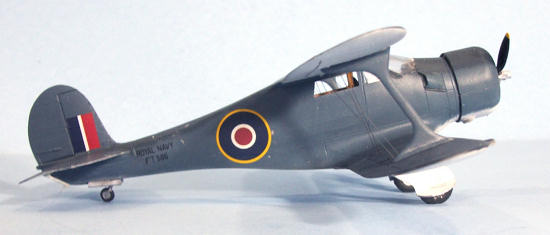 stabilizers,
and set these aside.
stabilizers,
and set these aside.
Overall, everything fit so well that I only needed to use some
cyanoacrylate glue along the centerline seam of the upper fuselage, and in the
area of the lower forward fuselage joint to the lower wing, with very light
sanding to smooth everything.
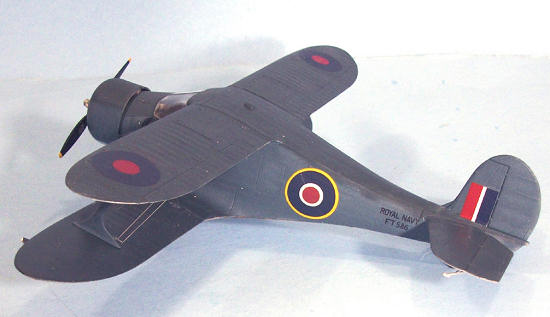 I attached the horizontal stabilizers, and made the mistake of attaching
the elevator counterweights. These
are small and thin and easily broken off, which I did, and then had to rebuild
one with Evergreen .010 rod. Do
yourself the favor of not attaching these till the last thing you do in final
assembly.
I attached the horizontal stabilizers, and made the mistake of attaching
the elevator counterweights. These
are small and thin and easily broken off, which I did, and then had to rebuild
one with Evergreen .010 rod. Do
yourself the favor of not attaching these till the last thing you do in final
assembly.
The engine went together without problem and fit inside the cowling.
Everything attached to the forward fuselage without problem.
I left off the upper wings for final assembly after painting, though I
made sure they fit right so I could attach them without glue during painting.
I discovered while attaching the clear parts that they don’t really fit.
I had to do a lot of test-fitting to get the windshield to fit, and the
side windows ever did too well. Fortunately, those windows roll down on a
Staggerwing, so leaving them open is an option, that or replace them with clear
plastic sheet cut to fit.
| COLORS & MARKINGS |
There are very few photographs of military Staggerwings out there.
I was able to determine by going to the online
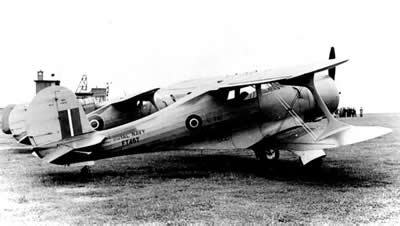 While perusing the
While perusing the
I used Tamiya Flat White, Intermediate Blue and Field Blue for the
camouflage, with some post-shading to the upper colors.
I pieced together decals from the Decal Dungeon to make an
otherwise-unidentified Fleet Air Arm Traveler Mk.I used around
| FINAL CONSTRUCTION |
I gave the model a coat of Xtracrylix Flat Varnish, then applied exhaust stains on the lower fuselage. I attached the upper wings and the interplane “I” struts, then used RB productions 4BA stainless steel wire for the simple wing bracing wires. I then unmasked the windscreen and attached the landing gear and prop.
| CONCLUSIONS |
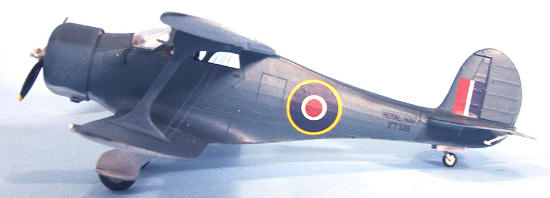 This is the Staggerwing kit I have been waiting for all these years.
The kit design is simple, and the result is bound to look superb.
But I sure do wish they’d included a nice set of civvy markings.
This is the Staggerwing kit I have been waiting for all these years.
The kit design is simple, and the result is bound to look superb.
But I sure do wish they’d included a nice set of civvy markings.
The Fighter Collection at Duxford has the only flying Staggerwing in
Great Britain, an airplane formerly owned by David Gilmour of Pink Floyd, which
is known to have been a Fleet Air Arm Traveller Mk. I, FT475. I know they have
been trying to decide what military markings to use for the restoration, and I
hereby suggest they take a look at this, it’s the best guess from the available
information.
Review kit courtesy of my wallet
If you would like your product reviewed fairly and quickly, please contact me or see other details in the Note to Contributors.